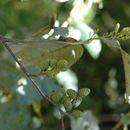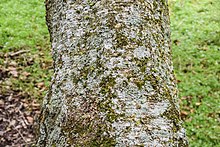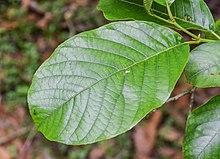pms
nòm ant ël fil


Alnus nepalensis (lat. Alnus nepalensis) - tozağacıkimilər fəsiləsinin qızılağac cinsinə aid bitki növü.
Alnus nepalensis (lat. Alnus nepalensis) - tozağacıkimilər fəsiləsinin qızılağac cinsinə aid bitki növü.
Alnus nepalensis is a large alder tree found in the subtropical highlands of the Himalayas. The tree is called Utis in Nepali and Nepalese alder in English. It is used in land reclamation, as firewood and for making charcoal.
Alnus nepalensis is a large deciduous alder with silver-gray bark that reaches up to 30 m in height and 60 cm in diameter. The leaves are alternate, simple, shallowly toothed, with prominent veins parallel to each other, 7–16 cm long and 5–10 cm broad. The flowers are catkins, with the male and female flowers separate but produced on the same tree. The male flowers are 10 to 25 cm (4 to 10 in) long and pendulous, while the female flowers are erect, 1 to 2 cm (0.4 to 0.8 in), with up to eight together in axillary racemes.[2] Unusually for an alder, they are produced in the autumn, with the seeds maturing the following year.
It occurs throughout the Himalaya at 500–3000 m of elevation from Pakistan through India, Nepal and Bhutan to Yunnan in southwest China. It grows best on deep volcanic loamy soils, but also grows on clay, sand and gravel. It tolerates a wide variety of soil types and grows well in very wet areas. It needs plenty of moisture in the soil and prefers streamside locations, but also grows on slopes.[3]
The tree grows quickly and is sometimes planted as erosion control on hillsides and for land recovery in shifting cultivation. It has nodules on the roots which fix nitrogen. The wood is moderately soft. It is occasionally used for making boxes and in light construction but is mainly used as firewood, when it burns evenly but rather rapidly, and for making charcoal. Currently, this tree species is preferred by different indigenous ethnic groups such as H'mong, Nung and Thu Lao in Simacai district, Lao Cai province, Northern Vietnam to regreen and enrich the forest by local knowledge (SPERI, CENDI).[2]
 Bark of Alnus nepalensis
Bark of Alnus nepalensis  Leaf of Alnus nepalensis
Leaf of Alnus nepalensis Alnus nepalensis is a large alder tree found in the subtropical highlands of the Himalayas. The tree is called Utis in Nepali and Nepalese alder in English. It is used in land reclamation, as firewood and for making charcoal.
Alnus nepalensis D.Don, es una especie de árbol perteneciente a la familia de las betuláceas.
Estos árboles subtropicales se encuentran en la sierra del Himalaya. Se denomina ITU en Nepal y Nepal Alder en Inglés. Se distribuye en toda la cordillera del Himalaya a 500-3000 m de altitud desde el Pakistán a través de Nepal y Bután a Yunnan en el sudoeste de China.
A. nepalensis es un aliso deciduos con corteza de color gris-plata que alcanza hasta 30 m de altura y su tronco 60 cm de diámetro. Las hojas están dentadas superficialmente, son de 7–16 cm de largo y 5–10 cm de ancho. Las flores se producen en el otoño, con las semillas madurando en el año siguiente. La madera del UTI es moderadamente suave. A veces es usado para hacer cajas, en la construcción, y como leña.
El árbol crece rápidamente y a veces se plantó para utilizarlo en el control de la erosión en las laderas y para la recuperación de la tierra en la rotación de cultivos. Es un árbol que fija el nitrógeno. Tolera una gran variedad de tipos de suelo y crece bien en zonas muy húmedas.
Alnus nepalensis fue descrita por David Don y publicado en Prodromus Florae Nepalensis 58. 1825.[1]
Alnus: nombre genérico del latín clásico para este género.[2]
nepalensis: epíteto geográfico que alude a su localización en Nepal.
Alnus nepalensis D.Don, es una especie de árbol perteneciente a la familia de las betuláceas.
Alnus nepalensis est une espèce d'arbres de la famille des Betulaceae. Originaire d'Asie (Chine, Bangladesh, Bhoutan, Inde, Népal, Birmanie, Thaïlande et Viêt Nam), il a été importé pour être cultivé dans d'autres pays d'Asie, mais aussi en Afrique et en Amérique.
Cette espèce a été décrite pour la première fois en 1825 par David Don[1].
Cette espèce a un tronc droit, elle pousse rapidement et peut atteindre une hauteur de 30 m. C'est une espèce pionnière qui pousse rapidement à la lumière mais qui tolère aussi l'ombre[2].
Alnus nepalensis est une espèce d'arbres de la famille des Betulaceae. Originaire d'Asie (Chine, Bangladesh, Bhoutan, Inde, Népal, Birmanie, Thaïlande et Viêt Nam), il a été importé pour être cultivé dans d'autres pays d'Asie, mais aussi en Afrique et en Amérique.
Cette espèce a été décrite pour la première fois en 1825 par David Don.
Alnus nepalensis er elritegund frá heittempruðum svæðum á hálendi Himalajafjalla. Það er kallað Utis á nepölsku. Það er notað til að endurheimta landgæði, sem eldiviður og til kolagerðar. Hann er ríkistré Indverska ríkisins Nagaland.
A. nepalensis er stórt lauffellandi elri með silfurgráum berki sem nær að 30 m hæð og 60 sm að bolþykkt. Blöðin eru stakstæð, heil, grunntennt, með áberandi æðum samsíða, 7–16 sm löng og 5–10 sm breið. Blómin eru í reklum, karl og kvenblóm aðskilin en á sama tré. Karlreklarnir eru 10 til 25 sm langir og hangandi, en kvenblómin eru upprétt, 1 til 2 sm löng, með allt að 8 saman í "axillary racemes".[2] Óvenjuleg fyrir elri þá koma blómin að hausti, með fræþroska árið eftir.
Hann vex í Himalajafjöllum í 500–3000 m hæð, frá Pakistan um Nepal og Bhutan til Yunnan í suðvestur Kína. Hann þolir mjög breytilegan jarðveg og vex mjög vel í mjög blautum svæðum. Hann þarfnast mikils raka og kýs helst að vera við ár, en vex einnig í hlíðum.[3]
Hann vex hratt og er stundum plantað sem rofvörn á fjallshlíðum og til endurhemtar landgæða í skiftirækt. Hann er með svepprótarhnýði sem binda nitur úr andrúmslofti. Timbrið er meðalhart. Það er stundum notað til að gera kassa og aðra létta smíði, en aðallega í eldivið, þar sem hann brennur hratt en jafnt, og í kolagerð. Eins og er er þessi tegund helst valin af mismunandi innfæddum þjóðarbrotum svo sem H'mong, Nung og Thu Lao í Simacai héraði (Lao Cai province, Norður Víetnam) til að endurheimta og auðga skóga með innfæddri þekkingu (SPERI, CENDI) [2]
Alnus nepalensis er elritegund frá heittempruðum svæðum á hálendi Himalajafjalla. Það er kallað Utis á nepölsku. Það er notað til að endurheimta landgæði, sem eldiviður og til kolagerðar. Hann er ríkistré Indverska ríkisins Nagaland.
L'ontano nepalese (Alnus nepalensis D.Don, 1825) è una pianta appartenente alla famiglia Betulaceae, diffusa negli altipiani subtropicali dell'Himalaya e in Cina.[1][2] L'albero viene chiamato "Utis" in nepalese. Viene utilizzato nella bonifica dei terreni, come legna da ardere e per la produzione di carbone vegetale.[1] È l'albero di stato dello stato indiano del Nagaland.
Le radici presentano dei noduli con i quali l’albero è in grado di fissare l'azoto.
L’alnus nepalensis è un grande ontano deciduo con corteccia di colore grigio-argento e può raggiungere i 30 m di altezza e 60 cm di diametro. Il suo legno è moderatamente morbido.[3]
Le foglie sono alterne, semplici, poco profonde, dentate, con venature prominenti e parallele tra loro, lunghe 7–16 cm e larghe 5–10 cm.[3]
I fiori sono raggruppati fino ad un massimo di otto in racemi.[3]
I fiori sono amenti, con i fiori maschili e femminili separati ma prodotti dallo stesso albero. I fiori maschili sono pendenti e lunghi da 10 a 25 cm, mentre i fiori femminili sono eretti e lunghi da 1 a 2 cm.[3] Insolitamente per un ontano, fioriscono in autunno, con i semi che maturano l'anno successivo.
L’ontano nepalese è distribuito in tutto l'Himalaya a 200–3600 m di altitudine, dal Pakistan attraverso il Nepal e il Bhutan fino allo Yunnan nella Cina sud-occidentale.[1] Cresce meglio su terreni argillosi vulcanici profondi, ma cresce anche su argilla, sabbia e ghiaia. Tollera un'ampia varietà di tipi di suolo e cresce bene in zone molto umide. Ha bisogno di molta umidità nel suolo e preferisce le posizioni lungo i fiumi, ma cresce anche sui pendii.[4]
L'albero cresce rapidamente e a volte viene piantato come controllo dell'erosione sui pendii collinari e per il recupero del terreno nella coltivazione a turno. Essendo morbido, viene occasionalmente utilizzato per la fabbricazione di scatole e nella costruzione leggera, ma viene usato principalmente come legna da ardere perché brucia in modo uniforme ma piuttosto rapido, e per la fabbricazione di carbone vegetale.[1] Attualmente, questa specie arborea è preferita da diversi gruppi etnici indigeni come H'mong, Nung e Thu Lao nel distretto di Simacai, nella provincia di Lao Cai nel Vietnam settentrionale, per rinverdire e arricchire la foresta grazie alle conoscenze locali.[3][5]
L'ontano nepalese (Alnus nepalensis D.Don, 1825) è una pianta appartenente alla famiglia Betulaceae, diffusa negli altipiani subtropicali dell'Himalaya e in Cina. L'albero viene chiamato "Utis" in nepalese. Viene utilizzato nella bonifica dei terreni, come legna da ardere e per la produzione di carbone vegetale. È l'albero di stato dello stato indiano del Nagaland.
Tống quá sủ[1] (danh pháp hai phần: Alnus nepalensis) là một loài thực vật có hoa trong họ Betulaceae. Loài này được D.Don mô tả khoa học đầu tiên năm 1825.[2] Cây này mọc khắp dãy Himalaya ở độ cao 500–3000 m, từ Pakistan qua Nepal, Bhutan đến Vân Nam (Trung Quốc) và bắc Việt Nam (Lào Cai, Hà Giang, Điện Biên, Lai Châu,...). Loài cây này đang được các nhóm dân tộc như H'mông, Nùng, Thù Lao ở Si Ma Cai, Lào Cai lựa chọn làm cây trồng phủ xanh, phục hồi và làm giàu rừng bằng tri thức địa phương với sự hỗ trợ của Viện SPERI [3]và Viện CENDI.
Dữ liệu liên quan tới Alnus nepalensis tại Wikispecies
Tống quá sủ (danh pháp hai phần: Alnus nepalensis) là một loài thực vật có hoa trong họ Betulaceae. Loài này được D.Don mô tả khoa học đầu tiên năm 1825. Cây này mọc khắp dãy Himalaya ở độ cao 500–3000 m, từ Pakistan qua Nepal, Bhutan đến Vân Nam (Trung Quốc) và bắc Việt Nam (Lào Cai, Hà Giang, Điện Biên, Lai Châu,...). Loài cây này đang được các nhóm dân tộc như H'mông, Nùng, Thù Lao ở Si Ma Cai, Lào Cai lựa chọn làm cây trồng phủ xanh, phục hồi và làm giàu rừng bằng tri thức địa phương với sự hỗ trợ của Viện SPERI và Viện CENDI.